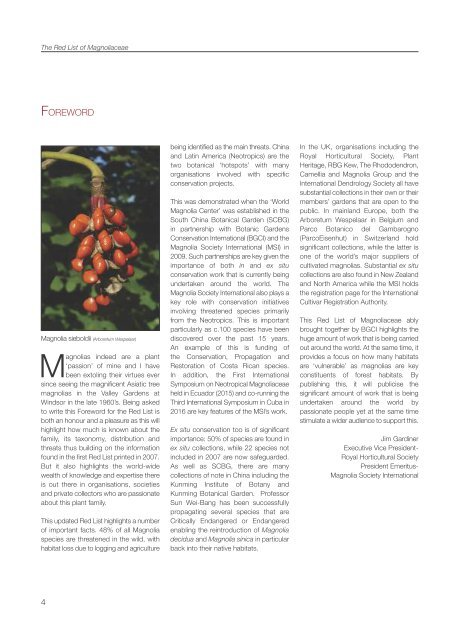Magnoliaceae
Magnoliaceae_RedList_2016_LowRes
Magnoliaceae_RedList_2016_LowRes
Create successful ePaper yourself
Turn your PDF publications into a flip-book with our unique Google optimized e-Paper software.
The Red List of <strong>Magnoliaceae</strong><br />
FOREWORD<br />
Magnolia sieboldii (Arboretum Wespelaar)<br />
Magnolias indeed are a plant<br />
‘passion’ of mine and I have<br />
been extoling their virtues ever<br />
since seeing the magnificent Asiatic tree<br />
magnolias in the Valley Gardens at<br />
Windsor in the late 1960’s. Being asked<br />
to write this Foreword for the Red List is<br />
both an honour and a pleasure as this will<br />
highlight how much is known about the<br />
family, its taxonomy, distribution and<br />
threats thus building on the information<br />
found in the first Red List printed in 2007.<br />
But it also highlights the world-wide<br />
wealth of knowledge and expertise there<br />
is out there in organisations, societies<br />
and private collectors who are passionate<br />
about this plant family.<br />
This updated Red List highlights a number<br />
of important facts. 48% of all Magnolia<br />
species are threatened in the wild, with<br />
habitat loss due to logging and agriculture<br />
being identified as the main threats. china<br />
and Latin America (neotropics) are the<br />
two botanical ‘hotspots’ with many<br />
organisations involved with specific<br />
conservation projects.<br />
This was demonstrated when the ‘World<br />
Magnolia center’ was established in the<br />
South china Botanical Garden (ScBG)<br />
in partnership with Botanic Gardens<br />
conservation International (BGcI) and the<br />
Magnolia Society International (MSI) in<br />
2009. Such partnerships are key given the<br />
importance of both in and ex situ<br />
conservation work that is currently being<br />
undertaken around the world. The<br />
Magnolia Society International also plays a<br />
key role with conservation initiatives<br />
involving threatened species primarily<br />
from the neotropics. This is important<br />
particularly as c.100 species have been<br />
discovered over the past 15 years.<br />
An example of this is funding of<br />
the conservation, Propagation and<br />
Restoration of costa Rican species.<br />
In addition, the First International<br />
Symposium on neotropical <strong>Magnoliaceae</strong><br />
held in Ecuador (2015) and co-running the<br />
Third International Symposium in cuba in<br />
2016 are key features of the MSI’s work.<br />
Ex situ conservation too is of significant<br />
importance: 50% of species are found in<br />
ex situ collections, while 22 species not<br />
included in 2007 are now safeguarded.<br />
As well as ScBG, there are many<br />
collections of note in china including the<br />
kunming Institute of Botany and<br />
kunming Botanical Garden. Professor<br />
Sun Wei-Bang has been successfully<br />
propagating several species that are<br />
critically Endangered or Endangered<br />
enabling the reintroduction of Magnolia<br />
decidua and Magnolia sinica in particular<br />
back into their native habitats.<br />
In the Uk, organisations including the<br />
Royal Horticultural Society, Plant<br />
Heritage, RBG kew, The Rhododendron,<br />
camellia and Magnolia Group and the<br />
International Dendrology Society all have<br />
substantial collections in their own or their<br />
members’ gardens that are open to the<br />
public. In mainland Europe, both the<br />
Arboretum Wespelaar in Belgium and<br />
Parco Botanico del Gambarogno<br />
(ParcoEisenhut) in Switzerland hold<br />
significant collections, while the latter is<br />
one of the world’s major suppliers of<br />
cultivated magnolias. Substantial ex situ<br />
collections are also found in new Zealand<br />
and north America while the MSI holds<br />
the registration page for the International<br />
cultivar Registration Authority.<br />
This Red List of <strong>Magnoliaceae</strong> ably<br />
brought together by BGcI highlights the<br />
huge amount of work that is being carried<br />
out around the world. At the same time, it<br />
provides a focus on how many habitats<br />
are ‘vulnerable’ as magnolias are key<br />
constituents of forest habitats. By<br />
publishing this, it will publicise the<br />
significant amount of work that is being<br />
undertaken around the world by<br />
passionate people yet at the same time<br />
stimulate a wider audience to support this.<br />
Jim Gardiner<br />
Executive Vice President-<br />
Royal Horticultural Society<br />
President Emeritus-<br />
Magnolia Society International<br />
4


